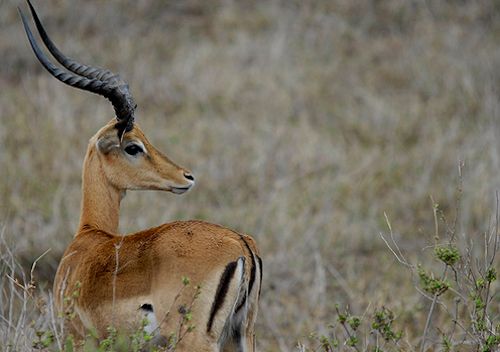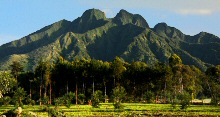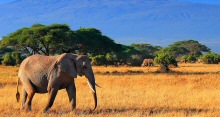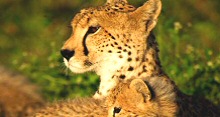 Uganda is one of the countries with such a huge population of Antelopes and they are distributed across all the 10 national parks and there are also different types of antelopes that found a home in these different game reserves and parks which you can see on your Safari in Uganda. Antelopes mainly live in the savannah regions, they are very common in the savannah plains on the East and Southern parts of Africa. They prefer regions with woodlands, bushes, semi-arid areas therefore they keep away from the swampy areas, the forested places and pure desert regions. They are therefore found in many national parks in Kenya, Rwanda, South Africa, Tanzania, Malawi, Zimbabwe and other countries within the same region but particularly in Uganda, they are found in almost every park. Many of them are found in Lake Mburo, Queen Elizabeth, Kidepo valley, Murchison fall, Semliki national park, among other game reserves.
Uganda is one of the countries with such a huge population of Antelopes and they are distributed across all the 10 national parks and there are also different types of antelopes that found a home in these different game reserves and parks which you can see on your Safari in Uganda. Antelopes mainly live in the savannah regions, they are very common in the savannah plains on the East and Southern parts of Africa. They prefer regions with woodlands, bushes, semi-arid areas therefore they keep away from the swampy areas, the forested places and pure desert regions. They are therefore found in many national parks in Kenya, Rwanda, South Africa, Tanzania, Malawi, Zimbabwe and other countries within the same region but particularly in Uganda, they are found in almost every park. Many of them are found in Lake Mburo, Queen Elizabeth, Kidepo valley, Murchison fall, Semliki national park, among other game reserves.
Common Characteristics of antelopes
All antelopes are herbivores which means they feed on the grass therefore they graze like the cattle and they prefer the succulent leaves, the flowers which they get during the rainy season but they also eat the low quality plants, the little trees, tubers, seeds and shrubs as well.
They don’t have a specific mating period therefore it can be any time as long as they have reached maturity and in general, they have a gestation period of 7-9 months at the end of which they all give birth to just a single calf at a time unless in un usual circumstances just as the case is among humans.
They are commonly seen in groups of about 500 members but of the same type of antelope and then the mothers as well as juveniles tend to form larger groups than that probably for the purposes of protection. The males however split into smaller groups and sometimes wonder off alone and sometime they tend to mix up with other types of antelopes.
They communicate using different gestures and vocalization especially when they see danger in proximity. In this case they have to alert the whole herd of the presence of probably a predator. Their predators include animals like the lions, the spotted hyenas, cheetahs too, wild dogs, among others. The young antelopes are vulnerable in this case compared to the grown-ups.
Among all types, the males ones are always large than the females therefore weigh more kilograms. There are about 29 different types of antelopes and these include animals like;
Types of antelopes
The Elands
There are the Elands which are also divided in to two types which are the giant and the common eland, the giant one is the largest antelopes while the common eland is the second largest but together they are considered as the largest antelops in the world because they can measure up to 180cm tall and grow as fat as the domestic cows. Elands have a light yellowish tan color/ fawn color with a distinctive black flap of skin that is between its throat and the chest. The Males have got those twisted thick and also tightly spiraled horns.
Elands feed in the morning and evening but may opt to feed in the night during the very hot days and then sleep for longer hours during day time. They get most of the water their bodies need from the food they eat therefore they can survive without drinking and only drink water when it becomes available.
The Kobs
The Kobs are the commonest types of antelopes and they are found in every national park as well as game reserve in Uganda and we refer to them as the Uganda kobs because it is a national symbol which appears on the coat of arms. They also live in groups of about 40 members, they are groups of either just females, just males or juveniles. The kobs look more like the impalas only that these are more robust more so the females and males grow darker as they age. The males are often taller and heavier than the females, they have that golden to reddish-brown coat, a white patch around the neck region underneath at the belly, inner parts of the ears and around the eye ring. The front parts of the legs black. They live like any other antelope.
The Greater Kudu
The Kudu are woodland antelopes, they are the second largest antelopes after the Elands and they have long and elegant spiral horns as well as 4-12 vertical white side stripes. They have got long legs supporting a very narrow body with their body coat either brown-grey color or reddish-brown color. The male ones are often bigger than the females, they have larger horns which have 2½ twists and these horns only start growing after the bull has turned 6 to 12 months old. When they grow up to 2 years, then the horns get the very first twist and they get the other and half twist when they are 3 years old. Sometimes, they make the 3rd twist a complete one.
The Jackson’s hartebeest
This hartebeest is light brown in color, relatively big since an adult male can weigh up to 218kgs. They have a flat face, curved horns, an up sloping body and an elongated forehead. In Uganda, you can find these animals only in Kidepo valley national park located in the north. What is unique about them is the fact that the females don’t form groups composed of other adult female but rather have those groups made up of like 4 generations of their own young ones and this is so because the females calves always stay close to their mothers until they give birth to their own little ones but still stay in the same group meanwhile the males sty with the mothers until they are like 3 years old. Male hartebeests form territories and they don’t stay away from their territories for long unless they are no longer interested in them.
There is also the waterbuck
This is also a large antelope and just like the name suggests, they prefers staying in places that are near the water like water banks and lake shore since the longest they can stay without drinking is a day or 2. Waterbucks prefer to graze on medium or short grasses because they are the best sources of protein and they can also feed on herbs and on foliage if there is scarcity of grass. There are about 37 subspecies of waterbuck’s categories basing on the color of their coats, they are classified into two groups which are the Ellipsen and the defassa waterbucks. They have got a shaggy coat which is reddish brown and grey, they color becomes darker with age and the male ones have a darker color. They have white muzzle area and very light eyebrows as well as the inner parts of the ears. Waterbucks have got long necks and short but very strong black legs too.
The Sitatunga
This type is rare and loves swampy areas, the mashes, thick vegetation and that makes it the semi-aquatic type of antelope. They have got splayed hooves to help them adapt to staying in the swampy- papyrus areas which is why in Uganda, you can expect them in places like the Bigodi swamp near Kibale national park, the Mabamba wetland in Entebbe, among other places.
They are usually active early in the morning, late in the evening and in the night, they have that shaggy hairy coat that is water-resistant and it varies in color. Only the male one grow horns which are spiral with 1or 2 twists and much as they are herbivore like all the other antelopes, they prefer fresh foliage, browse, fresh grass, sedges and aquatic plants thus the reason they rarely leave the swamps more during day.
Compared to the others, they living in very small groups of a male, about 4 females and may be 4 young one but usually, their group is made up of two members.
There are also the Grant’s gazelles,
These are the commonest in Uganda together with the Kobs. They have long sharp and spiral shape horns, a shinny brown coat but the lower areas around the belly and inner thigh-legs are pure white. They live in really large herds of about hundreds of individuals. The females eat the afterbirth all the other fluids so to keep its fawn clean and also scentless. They also stay as a group to protect themselves and their little ones from predators and they nurse the little one about 4 times every day therefore the mother stays very close to its infant especially during the few days when it can’t move. At 6 months they wean but still keep the young ones close. Other types that can be found in Uganda include the Impala which are also in plenty, the common reedbucks, the bushbucks, there are the duikers, the oribis, among so many others
There are so many other types of antelopes in the Africa but not in Uganda some of which are not found anywhere in Uganda, for example;
The Sable
These are also among the largest antelope in Africa. The females and males have those long very sharp horns with ring-like features with a nice black and white coat. They have a black face but the lowers, inner ears and belly region is white. The Males appear to be darker and females as well as the young ones have that paler chestnut kind of color.
The Nyala
These live in the dense bush especially around the riverine regions which are largely covered in vegetation. They are so hairy and a male Nyala is more like the kudu but the female ones can easily be confused with bushbucks. Males are different from the females in the color of coat since the male’s is dark and shaggy and also have horns yet the female Nyalas don’t have the fur and horns. Others include the Klipspringer antelopes, the Gemsbok antelopes, the mountain reedbucks, the roan antelopes, the Tsessebe, the wildebeests, the Suni and so many others types.
Antelopes can be seen during the nature walks and game drives in the different parks.
For more information about destination Uganda, visit adventureugnadasafari.com












